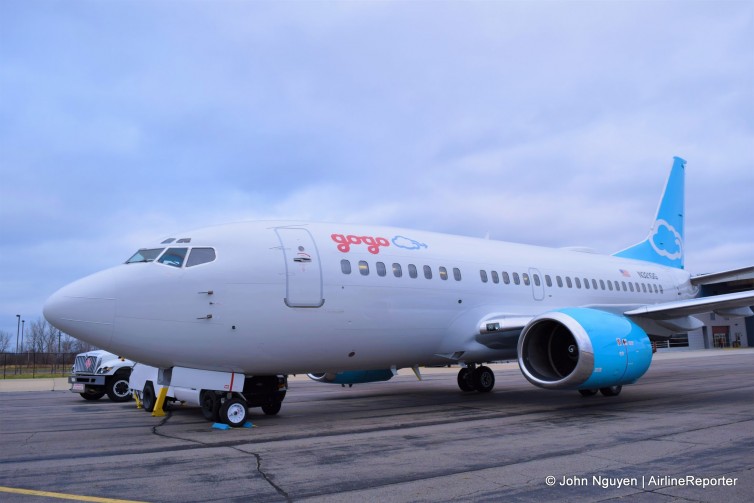
Gogo’s 737-500, N321GG a.k.a. the “Jimmy Ray”
Ok, I’ll admit that this flight review will be on an aircraft that 99.99% of the public won’t ever get the chance to fly, and I do feel badly about that… but it’s simply too cool for school to be on a private 737, more so because this particular 737 (a -500 model, reg. no. N321GG) currently has the fastest publicly-available inflight Wi-Fi Internet system in the world.
Gogo invited AirlineReporter and other media outlets to take flight on the “Jimmy Ray” to test out their new 2Ku system, which was debuted for the first time outside the company. While other tech-oriented companions were obsessed with reloading Speedtest and hammering the system with live streams, content streams, live feeds, and downloads, I was busy poking around the cabin features and amenities. Yea… I am an AvGeek.
Operator: Gogo
Aircraft: Boeing 737-5H7 (MSN 26445, Line No. 2327), CFM INTL CFM56-3C1 turbofans
Departed: Gary/Chicago International Airport (GYY) 2:05pm (+35 minute delay)
Arrived: Gary/Chicago International Airport (GYY) 3:08pm (+45 minutes delay)
Class of Service/Seat: First/3D
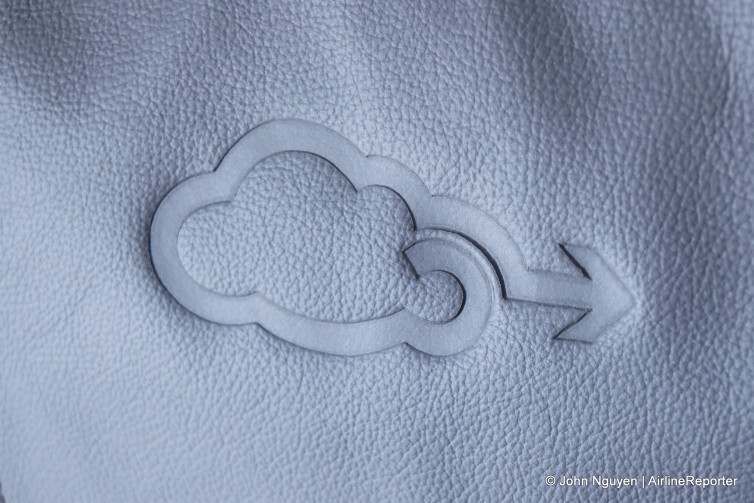
On board Gogo’s 737: Details; the embossing on the head rest covers.
GOGO 737 FLIGHT: At the airport
Our day would start at Gary/Chicago International Airport in northwest Indiana. Gogo planners had considered using either O’Hare or Midway in Chicago, but decided against those two options because of air traffic not being forgiving or flexible to the fluidity of our itinerary. Aurora, IL, where N321GG is normally based, was also ruled out due to being farther away from Gogo’s headquarters, as well as going with rush hour traffic.
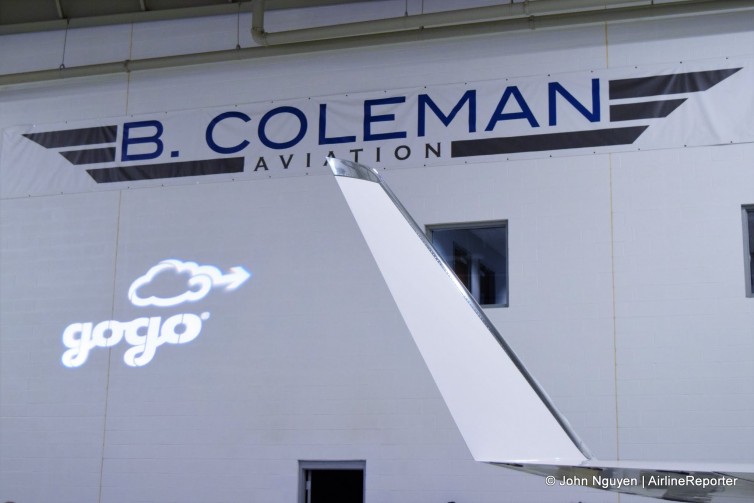
The private hanger, before our flight aboard Gogo’s 737-500
We arrived by charter bus from Chicago’s Loop to GYY and headed into a private terminal/hangar. It was a blustery, cloudy day, the type that gave pause to even the most seasoned flyers… we were in for a rough takeoff/landing. The lot of us had lunch while waiting, and when it finally came time to board the Jimmy Ray many of us (yours truly included) ran through the door and out to the tarmac like kids in a candy store.
I was snapping photos from all sorts of angles, taking a little bit of liberty in straying off the direct path to the airstairs, but not too much (probably due to the TSA-instilled fear we all have). But wait, this was a private flight out of a private terminal – we didn’t have anything to worry about! I was giddily taking my time with the glamour shots of N321GG, while almost everyone else boarded. I start walking towards the stairs to join them…
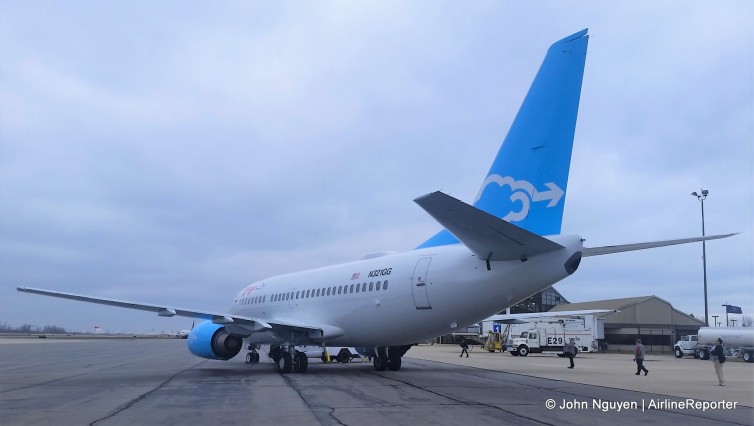
Gogo’s 737-500, N321GG a.k.a. the “Jimmy Ray”
GOGO 737 FLIGHT: Boarding… kind of. Ugh
NOT SO FAST. A Gogo rep/handler got my attention from behind and said that we had to go back to the building. I watched as he caught up to each individual to tell them the same thing, then boarded the plane. One by one, everyone got off and did the walk of shame back to the terminal building.
Apparently, the TSA caught wind of our little joyride and requested (read: ordered) Gogo to make us go through the proper screenings before departure. SAY WHAT???
The Gogo rep was extremely apologetic, saying that normally they could even drive the bus right up to the plane, board, and take off with no TSA in sight, and he was expecting to have a hassle- and screening-free trip this time around as well. As we stood in line to go through a metal detector that magically appeared (apparently they can be wheeled around), we came up with a list of factors (in no particular order) that may have prompted the TSA on this particular flight to act to protect our national security:
- The number of passengers was higher than usual for this flight;
- While N321GG is based in Aurora, we were technically flying out of an active commercial international airport, even though Gary hasn’t had scheduled commercial service since Allegiant left in August 2013;
- There were foreign passport holders among us geeks;
- It is TSA and there isn’t always a reason they do what they do.
In true Kabuki-style theatrics, we emptied our pockets, walked through the metal detector, and had our bags opened and searched. I don’t recall anyone getting any water confiscated, and those who beeped were simply walked through again after finding more metal on their person… no groping required.
After we were all deemed not likely to be terrorists, we walked back out to the tarmac to continue the day, now delayed by half-an-hour.
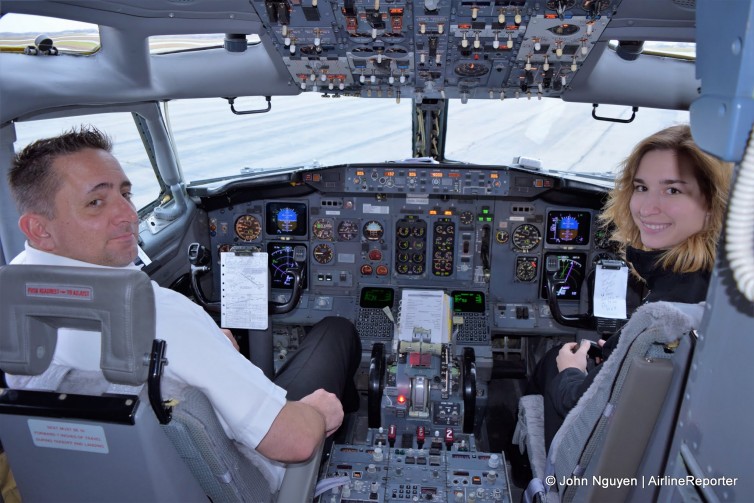
On board Gogo’s 737: Our flight deck crew on our little jaunt above the great State of Indiana
GOGO 737 FLIGHT: Onboard and inflight
A little bit about the Jimmy Ray: This particular 737-500 first took flight on June 29, 1992 and shortly thereafter started its commercial life with Malaysia Airlines, leased out by GECAS. After passing through Air France and CSA Czech Airlines, this airframe most recently flew with Orenair until it was returned to GECAS in June 2013 and put into storage. Gogo purchased it in January, 2015. N321GG was named after Gogo’s original founder.
We boarded through 1R, the door on the right (or starboard) side of the aircraft, where the catering truck normally pulls up to. I was greeted at the top of the airstairs by one of the flight attendants, who politely reminded me to duck because of the lower door height on that side. Even though I was in the middle of the crowd and it was open seating, there was still a free first class seat (on the aisle, to boot), so I shamelessly plopped down settled in.
- On board Gogo’s 737: Another look at the legroom in first class
- On board Gogo’s 737: The view from Seat 3C – look at that legroom!
The cabin has a maximum capacity of 149 seats, but Gogo went with a very low density layout of just 58 seats: 16 seats in first class and 42 in economy, all wrapped in a neutral medium-gray leather with leather headrest covers embossed with the Gogo logo. The seats were very comfortable, upholstered with memory foam. While the cabin retained the original overhead bins from two generations ago, LED mood lighting was added, as well as red vinyl bulkhead coverings, making the interior feel more modern. The unique features of N321GG: the multiple 110V outlets along the cabin wall, as well as dozens of CAT5 cabling running along the sides of the floor, to run all of their computers and equipment during normal flight tests.
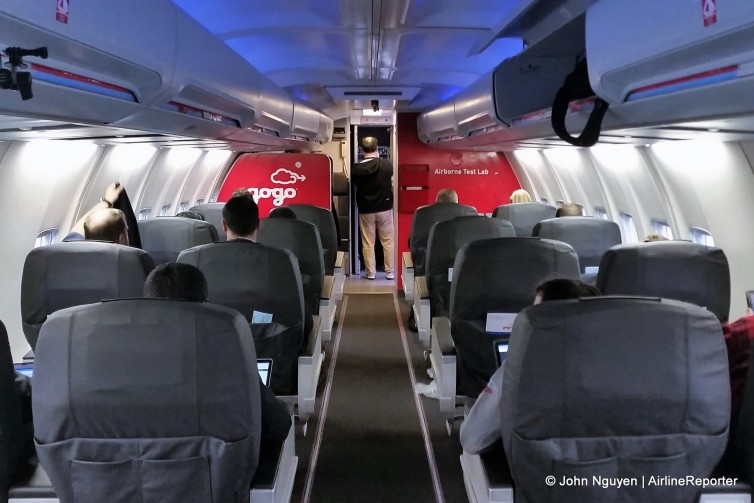
On board Gogo’s 737: Looking forward from mid-cabin; love the LED lights!
As we were preparing for takeoff, a recording gave us the standard instructions of buckling our seat belts and turning off and stowing our electronic devices, the last bit garnering a chuckle from the crowd. I did get a kick out of receiving a safety demo from our two lovely flight attendants on this flight, complete with safety instruction cards. We also received very nice amenity kits, matching those handed out in most international premium cabins.
- On board Gogo’s 737: Private jet or not, we still have to have the safety briefing
- On board Gogo’s 737: The safety card
Since we were there to sample Gogo’s 2Ku service, we all had our handheld devices (laptops were required to be stowed) powered up and connected to Wi-Fi from “gate to gate,” including during takeoff and landing.
We were underway in short order, and with no other activity or movement at the airport, we quickly made our way to the runway, turned, and accelerated in one motion. A smaller 737 with few passengers, no cargo, and no luggage takes off like a rocket, and we were airborne in what felt like under ten seconds. As expected, the crosswinds made it a bit rough, but we climbed quickly and had smooth air within five minutes.
As soon as the seatbelt sign went off, a flurry of noise and activity ensued, with everyone reaching for their laptops, cameras, second/third/nth devices, etc. While the focus for most was getting online with as many downloads as possible, I got up and started exploring the cabin itself.
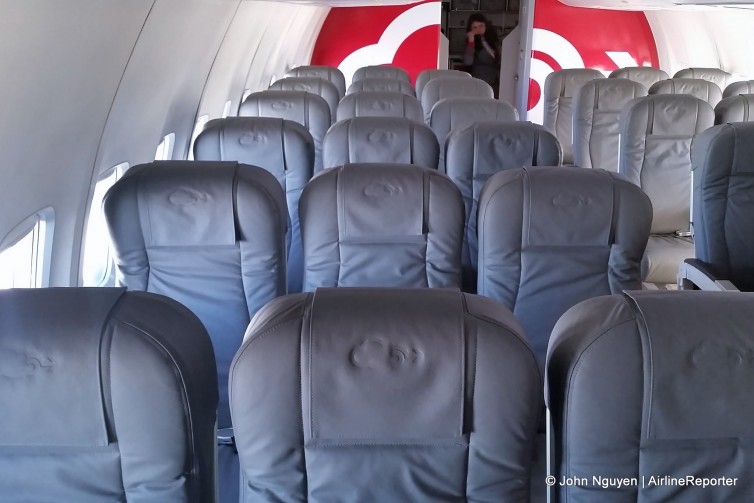
On board Gogo’s 737: Looking aft at the coach section
Most of the coach seats had a generous 35-36 inches of pitch, with the exit row offering a virtually infinite amount of leg space. First class featured a canyonesque 48 inches of pitch. The cushions in both classes were ample and firm, while the seat back was supportive. There were also empty areas behind the last row; I posited that they were for tiki bars or a pinball machine during inflight company holiday parties.
- On board Gogo’s 737: Another look at the legroom in first class
- On board Gogo’s 737: An ample 35-36″ of pitch in coach. Plus, memory foam.
- On board Gogo’s 737: Look and weep; the exit row
In case anyone really regretted eating before our flight, three lavatories were available. Also, the Jimmy Ray retained working galleys fore and aft.
- On board Gogo’s 737: The rear galley, fully functional
- On board Gogo’s 737: The lav, just in case lunch before our rough flight was a bad idea
I returned and was offered a beverage of my choice… how often does one get Mountain Dew on a flight anymore?
Our flight was all too short, and before we knew it, we had started to return to GYY. Interestingly, the descent was pretty bumpy until the last 500 feet in altitude, where we found clean air for a smooth landing. A short taxi back to the terminal building, and our little romp among the clouds was over.
- On board Gogo’s 737: Clear skies at 30K feet somewhere over Indiana
- On board Gogo’s 737: Our flight path: Image: FlightAware
- On board Gogo’s 737: Looking out on Gary, IN during final descent
What was surprising to me was that Gogo didn’t go all out with lavishness and bling on their own 737. Sure, there were a few extra touches here and there, but everything about the cabin setup was about recreating the most accurate commercial flight conditions they could, which should reassure the users, as well as investors, that Gogo takes its research and development seriously. Instead of creating a party bus with wings, they configured a plane that helps them achieve their mission objectives. That said, as an AvGeek, it was quite the thrill to be riding on the “Jimmy Ray.”
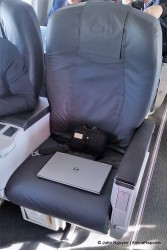
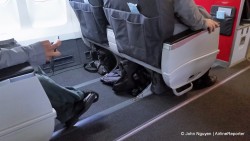
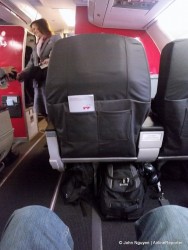
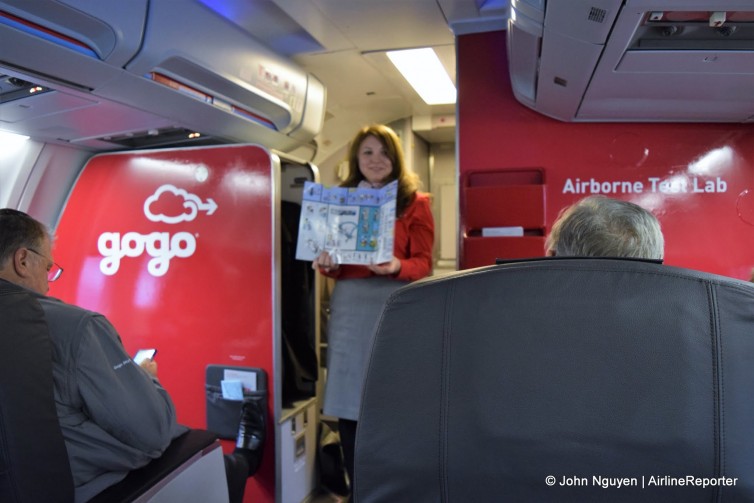
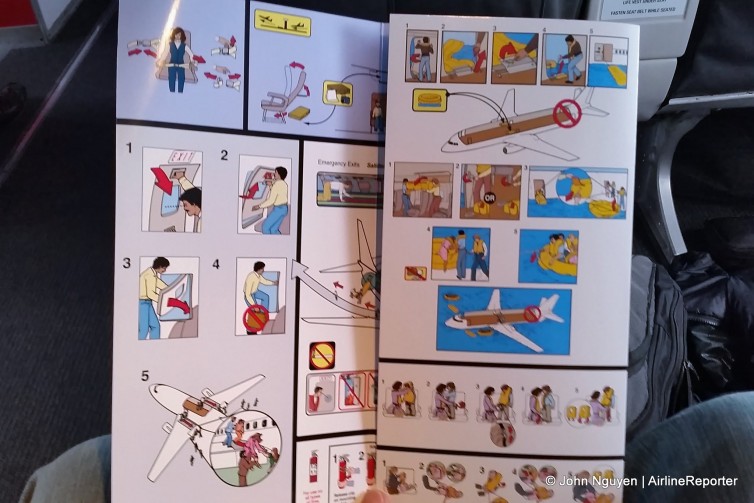
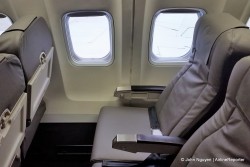
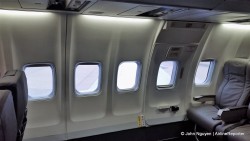
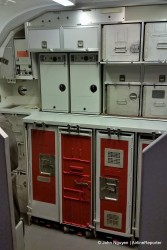
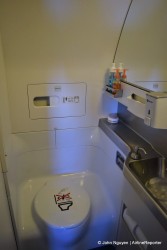
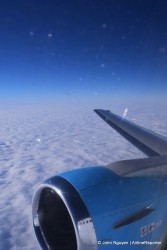
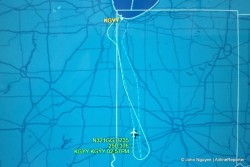
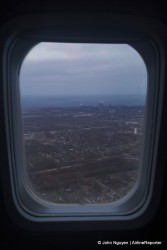
Fun story, but I didn’t have a clue what “Gogo” is, so I had to look it up on the Internet. I suspect that many people figured it was some new airline, as I did. Kind of confusing.
Hi Dan, sorry for the confusion. It was meant to be a fun piece, reviewing essentially a private jet/test vehicle as I would any other airliner. I suppose in a way, you’re proof that I succeeded!
John | AirlineReporter
Your shots of the cockpit tell a story most folks are unaware of. This airplane unlike any other airplane CANNOT be updated with regard to systems and the like because of LUV. LUV flys nothing but 737s and thus is able to keep their training costs to a minimum. The overhead panel as well as the instruments are vintage 60s tech. The newer models have incorporated more up to date instruments but the overhead panel remains the way it was conceived 45 years ago. That way LUV doesn’t have to provide additional training to its pilots. Any other airline with 3 to 6 different fleets, requires close to 10 training cycles when a seat comes open. So if a 787 captain retires, a new 78 captain must be trained who might be coming off a 777. That seat comes open and a 76 captain fills the empty seat and so on. One first officer from perhaps a 787 will now fill a captain’s seat on the smallest piece of equipment and then the same daisy chain happens with first officers. Everyone moves up one. Being trained on a new airplane often requires 3-4 weeks at the school house. When that happens, there’s one less guy flying an airplane. And so it goes. But LUV doesn’t have that problem. However…….the newer airplanes are set up in the cockpit much like previous airplanes to minimize the training costs so there’s only about a 2 week training period for coming off the 77 and on to the 78. Many of the systems are now quite similar.
Attention ALL AVGeeks: Here’s an update about the FIRST 727 at the Restoration Center @ PAE:
https://www.museumofflight.org/content/after-25-year-restoration-museum-prepping-historic-first-boeing-727-airliner-february-flight
I had the privilege of flying the 3 holers, both the -100 and -200. Just shows you how far we’ve come. The 72-100 was a real dog. Often times had to limit passengers to get off the runway, especially on hot days. The -100 model held about 100 folks while the stretch version, the -200 held 150 passengers. This was the last 3 pilot airplane. With the coming automation of fuel, pressurization, and hydraulic sytems, the flight engineer position which the 72 needed would be no longer needed. But the UAL union, ALPA, tried to protect the coming lost jobs by embracing the notion of safety.
ALPA made the case that a third set of eyes was critical in maintaining the safety of flight even though the future airplanes were designed to give both pilots more opportunity to see and avoid through automation of systems. The pilots at AA saw this strategy as more an issue of “featherbedding” and eventually broke with ALPA and began their own union, APA, which still stands today. The coming 75/76 fleet with this matter still not firmly settled when the design process for the new generation airplanes began, actually incorporated a flat panel that flight engineers could tinker with in back of the F/O seat, but thankfully, that never materialized.. Imagine the cost savings that the airline industry enjoyed with the advent of these new generation of airplanes. They would now only have to pay two pilots, provide health care, and provide retirement for two pilots instead of three. Not only that, but the new airplanes had huge fuel savings as well. As an aside both the S80/DC9s, and the 73s both had a jumpseat incorporated but was put in for check pilots and the Feds as opposed to a flight engineer seat.
MRBILL757, as I recall Eastern’s 727-125s seated 108 pax. I flew on Eastern and National 721s. I’d have to check my Flight Log to confirm whether or not I flew on a Pan American 721. I had flights on 722s, as well! Northeast and PSA, as I recall.
Being raised in Miami, about 5 mi. Due – South of MIA, I went to MIA to witness the arrival of Eastern’s FIRST 727-125 ( Reg. N103EA, if memory serves ). It parked at a gate on Concourse 2; as known back then. I remember the Arrival Celebration to this day!
I love reading all this additional history, thanks everyone!
John | AirlineReporter
Crazy Joe,
Down in Artesia, New Mexico, they actually have two old cockpits of 727s where FFDOs, (Federal Flight Deck Officers), i.e. armed pilots, receive training when qualifying to carry while flying. What a concept!! They are used as the last phase of training where bad guys storm in the cockpit and the pilots try to shoot the guys before they get much further than the cockpit door. Some of the best training I have ever received. They used to use paint balls and you can still see all the splattering of paint all over the cockpit, but they realized that a paint ball in a pilot’s eye could very well end a person’s career!! On another note, transitioning to the 727 was the easiest training I ever had since I had previously flown the -135s in the Air Force. It was just like old times – only better since the 72 had power steering unlike the -135s and it only had 3 throttles to manage instead of 4. Plus first class crew meals vs box lunches from the in-flight kitchen.
“This was the last 3 pilot airplane.”Are you including the F/E in this? I’m thinking the B747, DC-10 and the L-1011 both had flight engineer positions, didn’t they–and at least the first B737’s as well–and they were introduced after the B727. Curious–have any of the remaining B727’s been converted to two-person flight crews? An incredible jet, and glad the first one’s being preserved!
Uh… so after all of that, how fast was the wifi??? Wasn’t that sort of the whole point of your flight, to review the Gogo 2Ku service? Or was there an NDA?
There was wifi on board???
Just kidding – I actually wrote about the 2Ku technology in a previous story:
Gogo’s 2Ku Fast Inflight Internet – The Future is Soon!
https://www.airlinereporter.com/2015/12/the-future-is-soon-gogo-unveils-2ku-for-fast-inflight-internet/
John | AirlineReporter
Whoops! Thanks, John – I remember that story (especially the less than spectacular performance of 2Ku that day) but my short attention span somehow failed to connect it to this flight. Sorry!